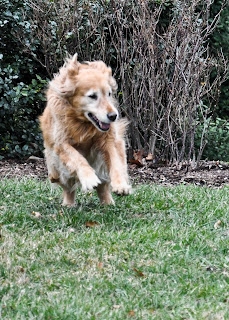Bailey
has always taken two distinct approaches to tug-o-war. Either she vigorously drives the game until
she captures the object of prey, or she hangs on and enjoys the ride until the
driver runs out of gas from boredom or exhaustion. In either case, she enjoys
the game thoroughly and almost always wins.
When
she was still a very young, very small pup, an adult dog cajoled Bailey to play
tug with it—patiently showing her that it was ok to take hold of the same stick
onto which his much larger and much more frightening teeth were also attached. He showed her the joys of pulling and
tugging, and even flying through the air when he lifted his head as Bailey held
on, her still un-plumed tail pointing the way and her ears flopping like
under-developed wings. He showed her
that growling is sometimes laughing, that snarling is sometimes smiling, and
that fighting is sometimes playing. And,
most important, he showed her how to recognize the difference.
From
then on, Bailey refined her tug-o-war strategies and mastered her technique. She soon developed two distinct
approaches. With some dogs (and all
humans), Bailey grabs on and takes charge—yanking, bucking, pulling, growling
and shaking vigorously in all directions.
She does the driving and she goes full throttle. With other dogs, however, Bailey simply holds
on and enjoys the ride. She poses no
resistance; instead allowing her opponent and gravity to do the work. Eventually, after many long minutes or only a
few seconds, one of two things will happen. Many dogs simply become bored or distracted
with Bailey’s lame stance, leading them to loosen their grip to discover
whatever sound or sight captured their attention. Bailey instantly seizes the
moment and the desired object. Or they will exert all of their energy pulling
65 pounds of Bailey weight around the park, until they wear themselves out and
fall from exhaustion. In either case her
opponents, be they canine or human, will eventually release or lose their grip,
as Bailey takes off gleefully in a lap of victory, waiving what is now her stick or rope or strip of fleece
proudly in the air like a flag. All hail the victor.

I
have never been able to determine how Bailey makes the decision of whether to
drive or ride. It may be something she
sees in her playmates’ eyes, or how they grip the object, or their first pull,
or some vibe they give off. I am clueless
to how she reaches this decision or even if the choice is conscious. But I do know that she makes the choice and
that it is the correct choice far more times than not.
Many
years and countless tugs of war have passed since the day Bailey first learned
to play the game, and she is now older than was the dog that taught her. Her
grip is no longer as tight and she is unable to endure nearly as
many rounds as when she was young. Still, to this day, Bailey enjoys a good
tug and she continues to employ the strategies that she
developed as a pup, and refined through her many years. She continues to demonstrate what is
important about tug—to grab on, hold on and enjoy the game—and life—to the end. To drive with as much vigor as can be mustered
when you drive, and to enjoy the ride without resistance when you ride. And, perhaps
most important of all, to know when to drive and when to ride.
Well
done Bailey.
.jpg)
.jpg)
.jpg)
